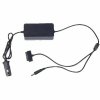Hi everyone,
I’m looking at purchasing a portable lithium power pack to charge my drone batteries and RC while travelling.
I’m completely illiterate when it comes to all things electrical so I was just wondering what sort of power does the genuine dji car charger use? My car charger is the single battery charging unit for p4p - does not charge two batteries at once.
The unit I’m looking at is a 21.5ah (see pic) which also has an inverter for AC use but I have no idea if it would be better to charge with that or via the 12v socket. I have both standard AC & car charger.
Just wondering if anyone could maybe tell me roughly how many battery charges I’d get out of this?
Many thanks for any advice.
I’m looking at purchasing a portable lithium power pack to charge my drone batteries and RC while travelling.
I’m completely illiterate when it comes to all things electrical so I was just wondering what sort of power does the genuine dji car charger use? My car charger is the single battery charging unit for p4p - does not charge two batteries at once.
The unit I’m looking at is a 21.5ah (see pic) which also has an inverter for AC use but I have no idea if it would be better to charge with that or via the 12v socket. I have both standard AC & car charger.
Just wondering if anyone could maybe tell me roughly how many battery charges I’d get out of this?
Many thanks for any advice.







